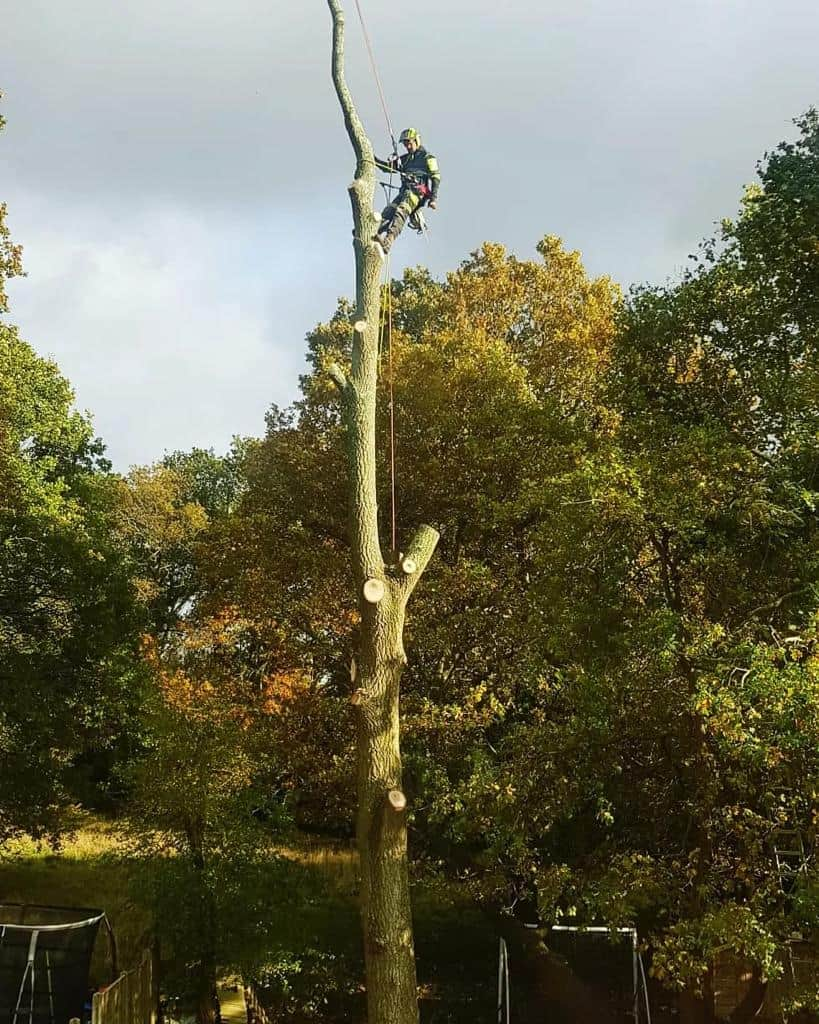When a tree is removed, many homeowners are left wondering what to do about the stump and, more importantly, what happens to the remaining roots. Stump grinding is a highly effective solution for removing tree stumps, but what about the roots that remain underground? At NS Tree Surgery Hindhead, we offer professional stump grinding services in Hindhead, Surrey, and are often asked about the impact on tree roots after the process. In this blog post, we’ll explain stump grinding in detail and what you can expect to happen to the tree roots.
1. What is Stump Grinding?
Stump grinding is the process of using a specialised machine to grind down the remaining tree stump after a tree has been felled. This method reduces the stump into small wood chips, which can then be used as mulch or removed from the site, leaving a clean, level surface where the tree once stood.
- How It Works: A stump grinder has a rotating blade that chips away at the wood, grinding it down to below ground level. Typically, stumps are ground to a depth of 6 to 12 inches below the soil, which is enough to cover the remaining stump with soil and grass.
- Why It’s Done: Stump grinding removes the unsightly stump left after tree removal, preventing issues such as tripping hazards, insect infestations, or interference with landscaping plans.
2. What Happens to Tree Roots After Stump Grinding?
While stump grinding removes the visible part of the tree, the roots remain underground. However, the roots no longer serve a purpose and will naturally decompose over time.
- Root Decomposition: Once the tree has been removed and the stump ground down, the roots are no longer receiving nutrients from the tree. Without the stump, the roots gradually die and begin to decompose. This process can take several years, depending on the size and type of the tree.
- Impact on Your Garden: In most cases, the remaining roots will not cause any harm to your garden. They will break down naturally, providing organic material to the surrounding soil. In some instances, roots close to the surface may decay faster than deeper roots, but this should not affect the overall health of your garden.
3. Can Tree Roots Regrow After Stump Grinding?
A common concern is whether tree roots can regrow after stump grinding. In most cases, the answer is no. Once the stump has been removed, the tree’s ability to regrow is severely diminished.
- Why Regrowth is Unlikely: Without the tree’s base (the stump), there is no longer a system to supply nutrients to the roots. While some tree species, such as certain types of poplar or willow, may attempt to sprout new growth from roots, these shoots are generally weak and can be easily controlled by regular mowing or herbicide treatment if necessary.
- Root Sprouts: In rare cases, small root sprouts may emerge from the remaining roots after stump grinding, but these can usually be dealt with by pruning or applying a suitable herbicide. It’s worth noting that any new growth is unlikely to develop into a fully grown tree.
4. Benefits of Stump Grinding Over Stump Removal
While stump grinding leaves the roots in place, it is generally considered a more efficient and less invasive solution than complete stump removal. Here are some of the key benefits:
- Less Disruption to the Surrounding Area: Stump grinding focuses on the stump itself, leaving the surrounding landscape undisturbed. Full stump removal, on the other hand, requires digging out the entire root system, which can cause significant disruption to your garden.
- Quick and Cost-Effective: Stump grinding is typically faster and more affordable than stump removal. It also leaves the area clean and ready for future landscaping or construction projects.
- Prevents Regrowth: By grinding down the stump, you effectively stop the tree from regrowing. Any root sprouts that do appear are minimal and easy to manage.
5. What Can You Do With the Ground Area?
After stump grinding, the area is usually left with a mixture of soil and wood chips. This creates a versatile space that can be used in various ways, depending on your landscaping plans.
- Replanting: Once the stump is removed, the area can be used to plant new grass, shrubs, or even a new tree. Keep in mind that the remaining roots will decompose over time, which may affect the growth of new plants in the short term.
- Landscaping: Many homeowners choose to cover the ground area with fresh soil or mulch after stump grinding, creating a level surface ready for a garden bed or patio installation.
Conclusion
Stump grinding is an efficient and effective way to remove tree stumps without disturbing the surrounding landscape. While the roots remain underground, they will gradually decompose, posing no significant risk to your garden. At NS Tree Surgery Hindhead, we provide expert stump grinding services that leave your garden clean, safe, and ready for future use. Whether you’re planning to replant or simply want to remove an unsightly stump, our team can help you achieve the results you need.
Call us on: 01428 778 689
Click here to find out more about NS Tree Surgery Hindhead
Click here to complete our contact form and see how we can help with your tree needs.

